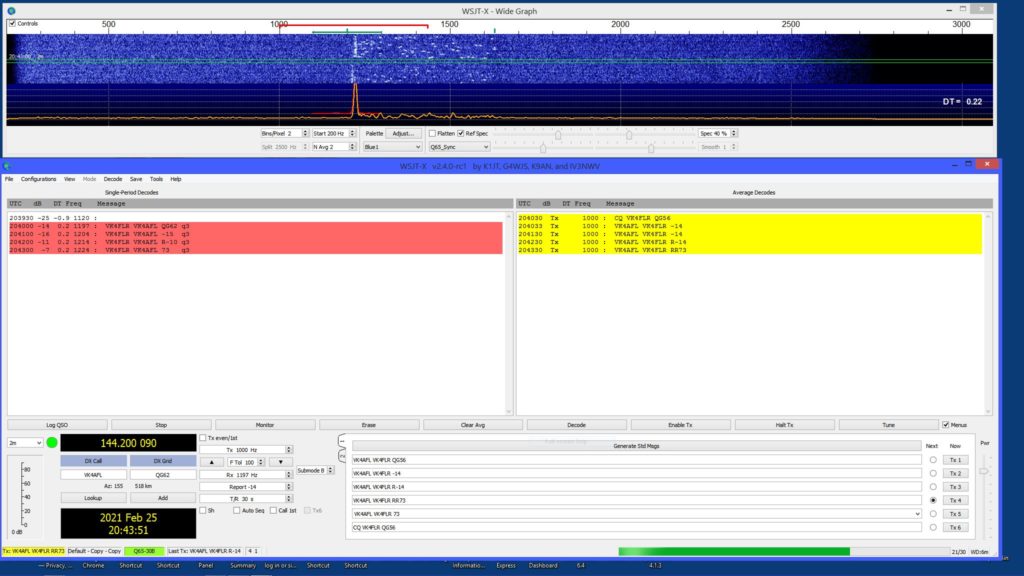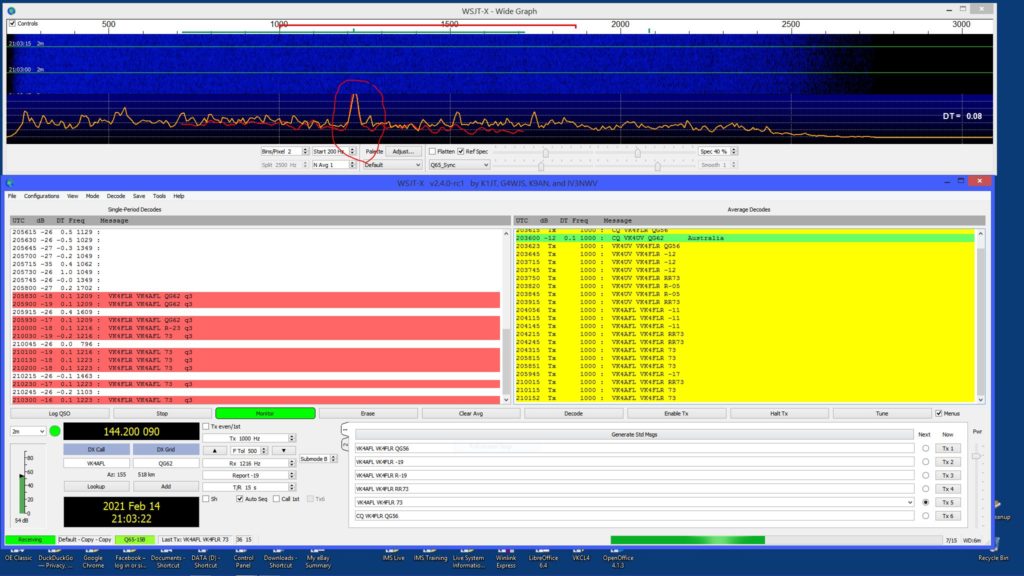Over the last few months a small group of Amateurs in VK4 have been testing Joe Taylors new WSJTX version 2.5
We spoke to both VK4AFL(Trevor) and VK4FLR(Frank) who have offered the following synopsis on their journey on the use of 2 metres and 23cm Q65 modes.
I have offered details of what I use for 23 cm terrestrial related to daily skeds with Frank VK4FLR @ 524 km.
Starting at the WSJT-X part of our skeds I initially used a single 31 element DL6WU yagi @ 47 ft which gave us FT8 contacts but not reliably. Going from a single 31 element to 4 of them improved gain by about 5 db which resulted in almost 100% success on a daily basis with many SSB completions.
Yagis used are spaced as per the DL6WU stacking formula & are phased with 200 ohm open wire line a system of phasing that I discovered in 1998 & applied to a 16 yagi 432 MHz array which is still in use today by another amateur. In the case of that array the reduction in loss compared to coax line & a multitude of connectors is more than 2 db which is roughly equivalent to doubling the size of the array.
The down side of the DL6WU 23 cm yagis is degraded wet weather performance which in heavy rain reduces the VK4RBB beacon by 20 db. I thought for some time that the open wire line was responsible for the high SWR/degradation but after building an identical 31 element yagi with a dipole/balun feed it behaved exactly the same. I set it up on a short pole with the ability to just copy the beacon & whilst monitoring return loss aimed a garden hose at the feed/reflector end of the yagi which made very little difference but as I worked the hose from D1 to D29 performance became very noticeably poorer until there was no beacon at all. Once it dried out in the sun all was normal. The 432 MHz yagis previously mentioned were of identical design but not affected by rain which given the frequency difference might be expected.
Following a run of LDF-550 there is about 200 watts at the feed point & I have experimented with lower power levels. Given the headroom available with WSJT reducing power by 3 db or even more still provides reliable contacts in fact 60 Watts in the shack would probably be enough.
As with any radio station the antenna system is by a huge margin the most important factor & unfortunately in the amateur sense is where frequently the least effort goes into.
Both Frank & myself have experimented with FT8, JT65 & Q65 proving conclusively that Q65-30B has them all beat by a big margin. In my opinion all else being equal a cooking 23 cm terrestrial station requires about 100 elements or more as high as possible with a minimum of 50 watts at the feed. A pre-amp is a big advantage but only if its mounted at the feed. If there is a typical 2-3 db or in many cases more loss in the feed system then your signal to noise ratio will be improved by at least that amount with a reasonable pre-amp at the feed. Because half of the vertical lobe is looking at ground noise [versus cold sky] the pre-amp doesn’t need to have a super low noise figure because that can never be taken advantage of unlike an EME application.

Spent some time this mornings most interesting session with QRA65 , , I have included screen shots , of our exchange Col & then Trevors session on 2m and also highlighting the selection of QR65 -(synch in the spectral waterfall display) and then the 23cm session with you Trevor …( I still having issues working out how to retain the correct display in the frequency box) I had the Q65 synch selected as per notes below.
https://physics.princeton.edu/pulsar/k1jt/Q65_Quick_Start.pdf – (see last page 4 screen snap attached ……).. 4. Notice that Q65 Sync has been selected at the bottom of the Wide Graph window. This choice enables the orange “sync curve,” a special Q65 feature that provides sensitive indications of where Q65 sync tones may be present. Here you can see significant spikes at the frequencies 697, 943, 1420, and 1620 Hz, and the Single-period Decodes panel shows decodes at each of these frequencies. Strong Q65 signals show additional “grass” on the orange curve to the right of the sync tone. The decoder generally ignores these. 5. Q65 decodes are always tagged with the lower-case letter “q” followed by one or two decimal digits. The first digit indicates the type of a priori (AP) information used, if any. When present, a second digit shows the number of Rx sequences that have been averaged to produce the decode.
The 23cm contact with Trevor was most significant , see the below screen shot of 23cm there was no trace on the water fall & I decoded him immediately on commenced TX , when the aircraft was well south of the hot spot , I first thought it was a false decode , & was unexpected …but I continued to decode him on every tx period , not a sign of signal in the speaker or waterfall !! notice the q3 codes on the decodes – so all that blew me away ………. certainly tries out your op skills out watching the sequences , taking screen shots & monitoring TX levels etc, all at the same time ………talk about multi tasking!!! Anyway, I think we are onto something special here with this fantastic latest WSJTX mode , as stated Trevor , extending the TX time sequences enhances the sensitivity even further …truly amazing software !

Frank gear consists of an old FT847 which has been temporally replaced by a FT857 due to the failure of the 847 on 2 & 70cm after 20 years of service plus the salt laden air here on the Capricorn coast has a high mortally rate on radio & computing gear I have found since shifting here 20 years ago from Rockhampton.
I am currently installing FT991A’s to take over the 2 , 70cm & 23cm ops .On 2m I run a modified AM18 solid state Collins linear amp ex DCA vintage which was designed as a 50w AM airband TX , but managed about 300w out of it after a few mods & better 28v 50A Power supply addition, this feeds a 13E yagi on the mast fed with LDF450 coax .
23cm gear basically comprises a on loan SG Labs 23cm transverter which drives a 300W LDMOS 28v amp also kindly on loan currently running around 150W output to a 36 element slot fed yagi 0n the roof fed with LDF450 coax.
I did build a Minkits 23cm 15W transverter many years ago & managed to work Trevor 4AFL & Ian 4AFC on the Atherton Table a number of times when we had some good tropo extensions, so that wetted my appetite for 23cm I guess along with my interest in tropo conditions that has maintained my interest.
About 12 months ago Trevor 4AFL approached me about doing some regular skeds firstly on 2m & then included 23cm as well with the better equipment & power setup, I did not think we had any chance to work regularly on 23cm ,and I give Trevor the full credit. He was very patient with me & we persisted & with his excellent station & antennas he proved me wrong.
We tried all sorts of modes including cw ,ssb , FT8 & WSJT modes with varying success mainly with Aircraft enhancement. Then along came the new Q65 addition in WSJTX suite which was a game changer , We found by experiment Q65 mode B30 sec sequencing enabled us to have mostly regular contacts on 2 & 23cm with AE enhancement over the 500km path most mornings at 20:30 Z.
So the journey continues, I must thank Trevor 4AFL for his patience & special support of me especially during the recent break I had to take during March /April to recover from the sudden loss of my XYL, of almost 50 years Lenore, on the 27th of March 2021 from a undiagnosed issue that was fatal. I miss her dearly !but I know she would want me to continue my radio hobby which has been a life saver to me during this time of my life !! also George 4AMG has been very supportive & a long time ex work colleague from the DCA days . Ron 4CRO has been supportive also & I do miss him on air !!
All aircraft details are via Airscout software.
As this is has been a popular adventure for both Frank and Trevor their following is growing up and down the Queensland coast with tropospheric Ducting(troppo) conditions and aircraft enhancement play a major part in the exercise. We all look forward to seeing you early one morning trying out your 1296MHz gear.
